Hydroponic Cannabis |
Hydroponic cannabis cultivation is revolutionizing the way we grow this versatile plant. By providing an alternative to traditional soil-based cultivation, hydroponics offers numerous advantages for cannabis growers. This method involves growing plants in a water-based nutrient solution, eliminating the need for soil while maximizing control over essential factors like nutrient delivery, pH levels, and environmental conditions. In this article, we will explore the benefits of hydroponic cannabis cultivation, discuss the essential components of a hydroponic system, provide guidance on selecting the right setup, delve into nutrient management and feeding techniques, and address common challenges faced by hydroponic cannabis growers. Whether you are a seasoned cultivator or a novice looking to embark on your cannabis growing journey, this guide will equip you with the knowledge and insights needed to excel in hydroponic cannabis cultivation.
|
Hydroponic Cannabis
Why Choose Hydroponics for Cannabis Cultivation?
Picture this: you're a cannabis enthusiast, ready to grow your own stash of top-quality buds. But here's the catch - you live in an apartment with no backyard. Don't despair! Enter hydroponic cannabis cultivation. With hydroponics, you can grow your weed indoors, without the need for soil. It's like cannabis gardening for the urban dweller.
Growing plants hydroponically:
- Hydroponics is a method of growing plants without soil, using mineral nutrient solutions in water. The nutrients provide everything the plants need to thrive.
- The water + nutrient solution is delivered to the plant roots by a number of methods including deep water culture, drip systems, NFT channels, aeroponics, ebb and flow systems and wick systems.
- Hydroponics allows plants to grow faster and often yield more compared to traditional soil methods since their roots get constant access to nutrients and oxygen.
- Indoor hydroponic systems allow year-round production of plants in controlled environments without concern for seasons, weather or soil conditions.
- Lettuce, tomatoes, cucumbers, herbs, peppers, and many other plants can be grown hydroponically. Certain fruits like strawberries also grow well this way.
- LED grow lights are commonly used to provide the necessary light levels for photosynthesis and growth in indoor hydroponic systems.
- Monitoring and maintaining adequate nutrient levels, pH, water oxygenation and temperature is crucial for optimal plant health and yields when growing hydroponically.
- While initial setup costs can be higher, hydroponics can reduce water usage, need less overall space, and eliminate issues like soil-borne diseases compared to standard gardening.
- Hydroponics has become popular for hobby growers and commercial operations looking to maximize plant growth and yields in a small footprint. Interest continues to grow in this soilless gardening method.
The History and Evolution of Hydroponic Cannabis
Hydroponics isn't a newfangled technique invented by some genius stoner. In fact, it dates back to ancient times, when the Hanging Gardens of Babylon used a primitive form of hydroponics to grow lush greenery. Fast forward to the 20th century, and scientists started experimenting with hydroponics for crop production. Eventually, cannabis enthusiasts caught on, realizing that hydroponics was the ultimate way to grow premium buds. The rest, as they say, is history.
Benefits of Growing Cannabis Hydroponically
Increased Growth Speed and Yield
If you're impatient, hydroponics is the way to go. Since plants get direct access to nutrients in a hydroponic system, they grow faster and produce higher yields. It's like giving your cannabis plants a VIP ticket to accelerated growth. Who doesn't want more buds, and faster?
Conservation of Water and Resources
We've all been through droughts, and we know how precious water can be. Hydroponics saves the day by reducing water usage. In a hydroponic system, water is recycled and reused, minimizing wastage. So not only do you get to grow your beloved cannabis, but you also get to feel like an eco-warrior while doing it. Win-win!
Minimized Risk of Pests and Diseases
Pests and diseases can be a grower's worst nightmare. But fear not, hydroponics has your back. By eliminating soil, hydroponic cultivation removes the cozy hiding spots and breeding grounds for unwanted critters. Say goodbye to creepy crawlies and hello to a stress-free growing experience. No need to call in the exterminator.
Main methods and systems used in hydroponic gardening:
- Deep Water Culture (DWC) - Plants are suspended in buckets or reservoirs of nutrient solution with the roots fully immersed and an air pump provides oxygenation.
- NFT (Nutrient Film Technique) - Plants are placed in channels and a thin film of nutrient solution runs past the bare roots then drains away.
- Drip Systems - Nutrient solution is dripped slowly onto the base of each plant from above. Solenoid valves control timing.
- Ebb & Flow (Flood and Drain) - Plants sit in an empty tray that floods with nutrient solution from the reservoir then drains back down in a cycle.
- Wick Systems - A porous wick carries nutrient solution from the reservoir up to the plant roots. No power required.
- Aeroponics - Plant roots are misted with an air-nutrient solution spray in a light-proof enclosure. Does not use growing media.
- Media Culture - Plants are anchored in substrates like perlite, clay pebbles, vermiculite, rockwool while being fed the nutrient solution.
- Vertical Farming - Growing plants stacked vertically in columns or on walls maximizes space. Often uses NFT or drip irrigation.
- Home DIY Systems - Consumer hydro kits, 5-gal buckets, storage totes can all easily be adapted into small home hydroponic systems.
The choice of which hydroponic system to use depends on space, budget, plant types, and individual preferences. All share the same core principle of growing plants in nutrient solutions without soil. |
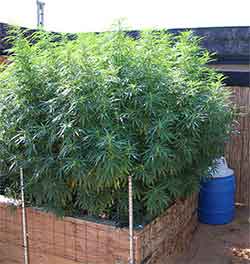
|
Essential Components of a Hydroponic Cannabis System
Growing Mediums for Hydroponic Cannabis
Without soil, you'll need another medium to support your cannabis plants. Popular options include coconut coir, rockwool, and perlite. Think of it as a comfy home for your precious green babies.
Hydroponic Systems: Types and Variations
There's no one-size-fits-all when it comes to hydroponic systems. From the straightforward drip system to the futuristic aeroponics, you've got options. It's like choosing the perfect gadget for your cannabis-growing needs. How cool is that?
Lighting Considerations for Indoor Hydroponic Cultivation
Plants need light, just like we need coffee to function. In an indoor hydroponic setup, you'll need to provide artificial lighting for your cannabis plants. LED lights are a popular choice, offering energy efficiency and just the right spectrum for optimal growth. Your plants won't know whether they're basking in natural sunlight or chilling under a fancy LED panel. |
Choosing the Right Hydroponic Setup for Cannabis Cultivation
Factors to Consider when Selecting a Hydroponic System
Choosing a hydroponic system is like picking a partner - it requires some thought. Factors such as space availability, your experience level, and the number of plants you want to grow should all be taken into account. It's a big decision, but don't worry, we've got your back.
Indoor vs. Outdoor Hydroponic Cannabis Cultivation
Indoor or outdoor? That is the question. Both options have their pros and cons. Indoor cultivation gives you control over every aspect, from lighting to climate, while outdoor growing lets Mother Nature lend a helping hand. It's like choosing between a cozy studio apartment or a spacious countryside cottage. Decide what suits your green thumb best.
Budgeting and Cost Considerations
Breaking news: growing cannabis hydroponically won't break the bank, but it still requires some investment. From the cost of equipment to ongoing expenses like electricity and nutrients, budgeting is essential. But fear not, fellow frugal growers, there are options for every wallet size. Just remember, the more you invest, the more you'll reap (literally).
And there you have it, the lowdown on hydroponic cannabis. Whether you choose to embark on this soilless journey to grow your own stash or simply find the topic fascinating, you've learned something new. Now go forth and impress your friends with your newfound hydroponic knowledge. Happy growing!
Nutrient Management and Feeding Techniques in Hydroponic Cannabis
Understanding Essential Nutrients for Cannabis Plants
When it comes to growing hydroponic cannabis, understanding the essential nutrients that your plants need is key. Just like humans need a balanced diet, cannabis plants require a mix of macronutrients, such as nitrogen, phosphorus, and potassium, as well as micronutrients like iron, zinc, and manganese. Think of these nutrients as the cannabis equivalent of a well-rounded meal.
Feeding Schedules and Techniques for Hydroponic Cultivation
Now that you know what nutrients your cannabis plants need, it's time to figure out how to feed them. One popular method is the "nutrient film technique," where a thin film of nutrient-rich water flows over the roots. Another option is the "drip irrigation system," which delivers nutrients directly to the root zone. Experiment with different techniques to find the one that works best for you and your plants.
Common Nutrient Deficiencies and How to Address Them
Sometimes, despite your best efforts, your cannabis plants might show signs of nutrient deficiencies. Don't panic! It happens to the best of us. If your plants look pale and lackluster, they might be lacking nitrogen. If the leaves are turning yellow, it's a sign of a potential magnesium deficiency. Understanding the symptoms of these deficiencies and knowing how to address them with nutrient supplements can help you get your plants back on track.
Managing pH and EC Levels for Optimal Cannabis Growth
The Importance of pH and EC in Hydroponic Cannabis
pH and EC might sound like alphabet soup, but they are crucial factors in hydroponic cannabis cultivation. pH refers to the acidity or alkalinity of the nutrient solution, while EC measures the electrical conductivity, which indicates the nutrient concentration. Getting these levels right ensures that your plants can absorb nutrients effectively and avoid nutrient lockout, where excess minerals prevent nutrient uptake.
Measuring and Adjusting pH Levels
Measuring pH is as important as taking a selfie with your plants, but instead of a camera, you'll need a pH meter. Aim for a pH range between 5.5 and 6.5, depending on the growth stage of your cannabis plants. If the pH is off, don't fret! You can adjust it by using pH-up or pH-down solutions to bring it back into the sweet spot. Remember, pH is the key to a harmonious relationship between your plants and their nutrients.
Optimizing Electrical Conductivity (EC) for Cannabis Plants
Just like your favorite workout routine, cannabis plants thrive with the right level of EC. Too high, and your plants might experience nutrient burn. Too low, and they might not get all the nutrients they need. Aim for an EC range that suits your chosen strain and the specific growth stage. Keep an eye on your plants' overall health and adjust nutrient concentrations accordingly. It's all about finding that EC Goldilocks zone. |
Common Challenges and Troubleshooting in Hydroponic Cannabis Cultivation
Dealing with Pests and Diseases in Hydroponic Systems
Even in the clean and controlled world of hydroponics, pests and diseases can still find a way to crash the party. Whether it's aphids, spider mites, or powdery mildew, vigilance is key. Regularly inspect your plants, use beneficial insects as biological control, and consider preventive measures like neem oil or organic pest sprays. Remember, pests and diseases are the uninvited guests no one wants, so show them the door!
Managing Temperature and Humidity Levels
Being a cannabis plant isn't easy, especially when it comes to finding the perfect temperature and humidity balance. Aim for a temperature range between 70°F and 85°F (21°C and 29°C) during the day and slightly cooler at night. As for humidity, keep it around 50-60% during the vegetative stage and reduce it to 40-50% during flowering. A comfortable environment will ensure happy and healthy plants.
Addressing Root-related Issues in Hydroponic Cannabis
Just like humans, cannabis plants need a solid foundation, and that starts with healthy roots. Root-related issues like root rot or nutrient deficiencies can impact your plants' overall health. To prevent problems, make sure your hydroponic system has good oxygenation, avoid overwatering, and maintain a clean and sterile environment. Healthy roots mean happy cannabis plants ready to show off their top-notch buds. |
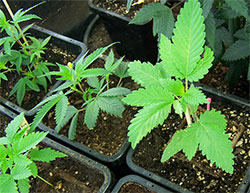
|
Harvesting and Processing Hydroponically Grown Cannabis
Knowing When to Harvest Hydroponic Cannabis Plants
Ah, the moment of truth! Harvesting hydroponically grown cannabis is like waiting for a pizza delivery—it's exciting and worth the wait. Keep an eye on the trichomes (those tiny, sticky resin glands on the buds) and look for a milky-white color for a more uplifting effect or amber for a more relaxing experience. Once the trichomes are mature, it's time to break out the scissors and start snipping those beautiful buds.
Proper Drying and Curing Techniques
Drying and curing cannabis is like aging a fine wine—it enhances the flavor, aroma, and overall quality. After harvesting, hang your buds upside down in a cool, dark, and well-ventilated space. Allow them to dry slowly until the stems snap instead of bending. Once dry, give your buds a little extra love by placing them in airtight containers for a curing period of two to four weeks. Patience is a virtue, my cannabis-loving friend.In conclusion, hydroponic cannabis cultivation offers a promising and efficient method for growing high-quality cannabis. With its numerous benefits, such as increased growth speed, resource conservation, and minimized risks of pests and diseases, hydroponics is gaining popularity among cannabis growers worldwide. By understanding the essential components of a hydroponic system, selecting the right setup, and mastering nutrient management and feeding techniques, cultivators can optimize their yields and produce top-tier cannabis. While there may be challenges along the way, armed with knowledge and troubleshooting strategies, growers can overcome obstacles and achieve success in their hydroponic cannabis cultivation endeavors. So, whether you're a commercial producer or a home grower, consider harnessing the power of hydroponics to unlock the full potential of your cannabis cultivation. |
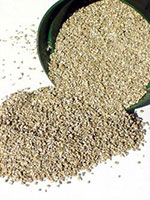
Vermiculite |
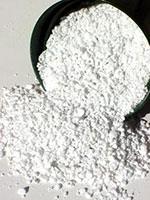
Perlite |
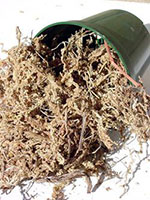
Sphagnum Moss |
FAQs about Hydroponic Cannabis
Is hydroponic cannabis cultivation legal?
Yes, the legality of cannabis cultivation, including hydroponics, varies by jurisdiction. It is important to research and understand the specific regulations and restrictions in your area before engaging in any cannabis cultivation activities.
Can I use hydroponics for outdoor cannabis cultivation?
While hydroponics is commonly associated with indoor cultivation, it is also applicable for outdoor cannabis growing. However, outdoor hydroponic systems may require additional considerations such as protection from extreme weather conditions and proper selection of outdoor-friendly hydroponic setups.
How often should I adjust the pH and nutrient levels in my hydroponic system?
The frequency of pH and nutrient level adjustments in a hydroponic system depends on various factors such as the size of the system, stage of plant growth, and water quality. Generally, it is recommended to monitor and adjust pH levels daily and nutrient levels on a regular basis as recommended by the nutrient manufacturer or based on the specific needs of your plants.
Can I grow organic hydroponic cannabis?
Yes, it is possible to grow organic hydroponic cannabis. Organic hydroponics typically involves using organic nutrient solutions and adhering to organic cultivation practices. However, it is important to note that certification standards for organic cultivation may vary, and it is advisable to research and follow the guidelines and regulations established by organic certification bodies in your region. |






